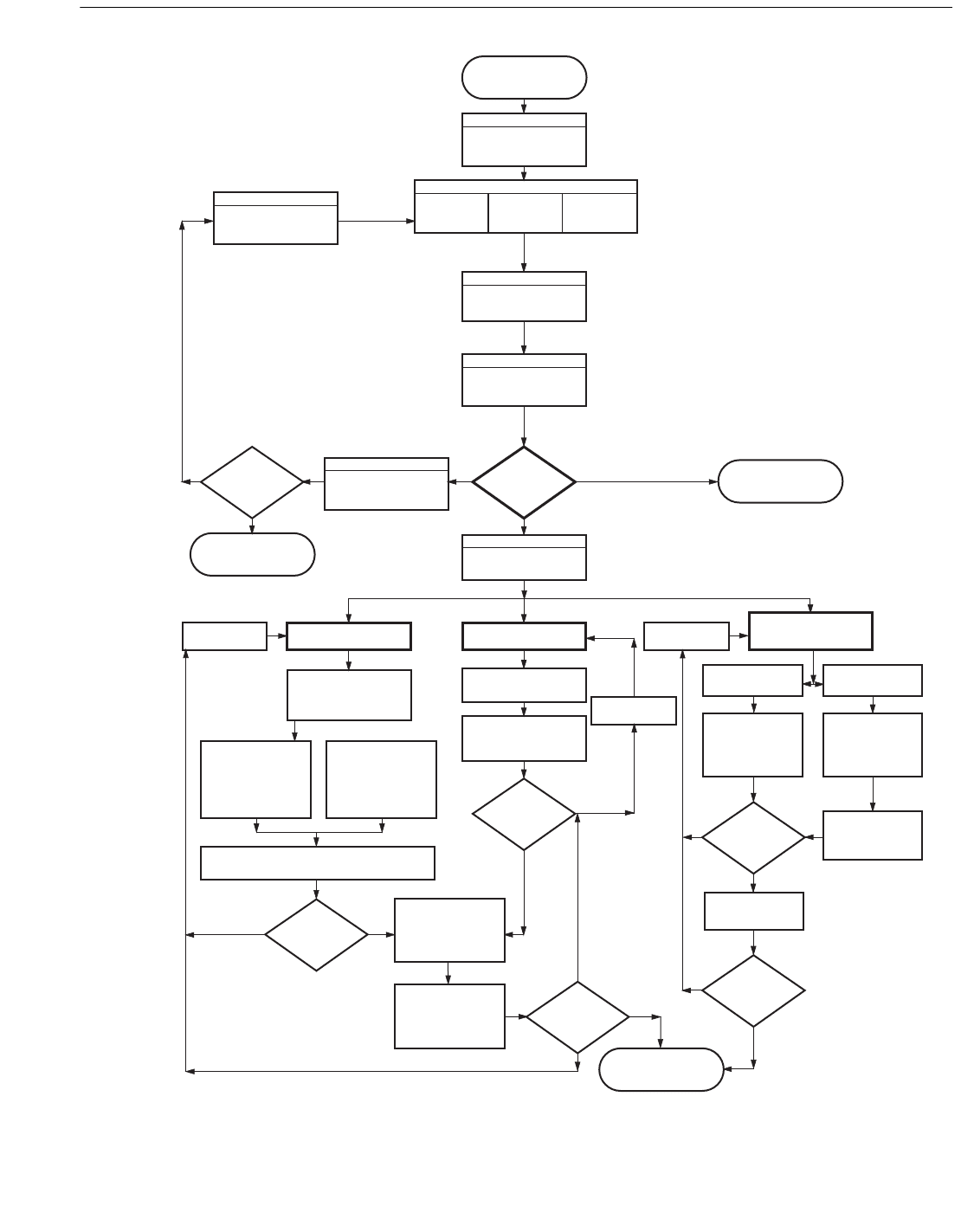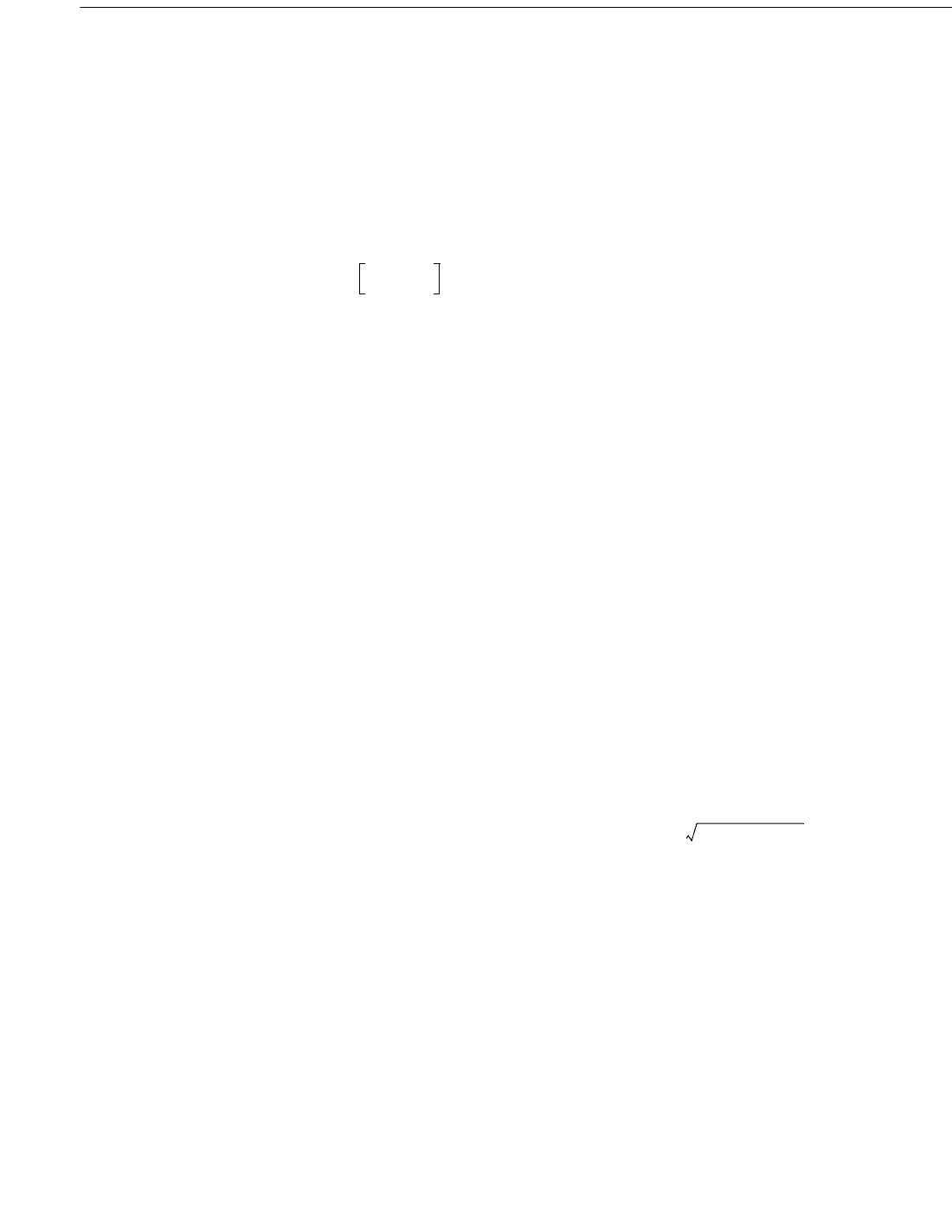API RP 2A-WSD-2007 Recommended Practice for Planning, Designing and Constructing Fixed Offshore Platforms-Working Stress Design
Подождите немного. Документ загружается.


RECOMMENDED PRACTICE FOR PLANNING, DESIGNING AND CONSTRUCTING FIXED OFFSHORE PLATFORMS—WORKING STRESS DESIGN 129
3. Design basis check: Only applicable to U.S. Gulf of
Mexico platforms.
4. Design level and ultimate strength analysis: Table
17.6.2-2 presents the 100-year metocean criteria neces-
sary for performing design level and ultimate strength
checks. An ultimate strength check will be needed if
the platform does not pass the design level check, or if
the deck height is not adequate.
The criteria are for deep water (that is, greater than
91 meters [300 feet]) and should be applied omnidirec-
tionally. Lower wave heights, provided they are sub-
stantiated with appropriate computations, may be
justified for shallower water.
17.6.3 Seismic Criteria/Loads
Guidance on the selection of seismic criteria and loading is
provided in 2.3.6 and C2.3.6. Additional details can be found
in “Assessment of High Consequence-Platforms—Issues and
Applications,” by M.J.K. Craig and K.A. Digre [7]. In addi-
tion, the following applies:
1. The design basis check procedures noted in 17.5.3.4
are appropriate provided no significant new faults in
the local area have been discovered, or any other infor-
mation regarding site seismic hazard characterization
has been developed that significantly increases the
level of seismic loading used in the platform’s original
design.
2. For seismic assessment purposes, the design level
check is felt to be an operator’s economic risk decision
and, thus, is not applicable. An ultimate strength analy-
sis is required if the platform does not pass the design
basis check or screening.
3. Ultimate strength seismic criteria is set at a median
1,000-year return period event for all platforms except
those classified as minimum consequence. For the
minimum consequence structures, a median 500-year
return period event should be utilized. Characteristics
of these seismic events should be based on the consid-
erations noted in 2.3.6 and C2.3.6 as well as any other
significant new developments in site seismic hazard
characterization. The ultimate strength seismic criteria
should be developed for each specific site or platform
vicinity using best available technology.
17.6.4 Ice Criteria/Loads
Guidance on the selection of appropriate ice criteria and
loading can be found in API Recommended Practice 2N, 1st
Edition, 1988. Note that the ice feature geometries provided
in Section 3.5.7 of API Recommended Practice 2N are not
associated with any return period as no encounter statistics
are presented. All references to screening, design level, and
ultimate strength analyses in Section 17.5.4 assume the use of
the values noted in Table 3.5.7 of API Recommended Prac-
tice 2N. Where ranges are noted, the smaller number could be
related to design level and the larger related to ultimate
strength. Additional details can be found in “Assessment of
High Consequence Platforms—Issues and Applications,” by
M.J.K. Craig and K.A. Digre [7].
17.7 STRUCTURAL ANALYSIS FOR
ASSESSMENT
17.7.1 General
Structural analysis for assessment shall be performed in
accordance with Sections 3, 4, 5, 6, and 7 with exceptions,
modifications and/or additions noted herein. Additional infor-
mation and references can be found in “Structural Assess-
ment of Existing Platforms,” by J. Kallaby, et. al. [3].
A structure should be evaluated based on its current condi-
tion, accounting for any damage, repair, scour, or other fac-
tors affecting its performance or integrity. Guidance on
assessment information is provided in Section 17.4. The glo-
bal structural model should be three-dimensional. Special
attention should be given to defensible representation of the
actual stiffness of damaged or corroded members and joints.
For platforms in areas subjected to ice loading, special
attention should be given to exposed critical connections
where steel that was not specifically specified for low temper-
ature service was used.
17.7.2 Design Level Analysis Procedures
17.7.2.a General
Platforms of all exposure categories that do not pass the
screening requirements may be evaluated using the design
level procedures outlined below. These procedures may be
bypassed by using the ultimate strength analysis procedures
described in 17.7.3.
17.7.2.b Structural Steel Design
The assessment of structural members shall be in accor-
dance with the requirements of Section 3, except as noted
otherwise in this section. Effective length (K) factors other
than those noted in 3.3.1d may be used when justified. Dam-
aged or repaired members may be evaluated using a rational,
defensible engineering approach, including historical expo-
sure or specialized procedures developed for that purpose.
17.7.2.c Connections
The evaluation of structural connections shall be in accor-
dance with Section 4, except as noted otherwise in this sec-
tion. The criteria listed in Section 4.1, which require that
joints be able to carry at least 50 percent of the buckling load
for compression members and at least 50 percent of the yield
Copyright American Petroleum Institute
Provided by IHS under license with API
Licensee=Indonesia location/5940240008
Not for Resale, 10/22/2008 00:07:12 MDT
--`,,```,,,`,,,,,,,,,,,,,,`,``,`-`-`,,`,,`,`,,`---

130 API RECOMMENDED PRACTICE 2A-WSD
stress for members loaded primarily in tension, need not be
met. Tubular joints should be evaluated for the actual loads
derived from the global analysis. The strength of grouted and
ungrouted joints may be based on the results of ongoing
experimental and analytical studies if it can be demonstrated
that these results are applicable, valid, and defensible. For
assessment purposes, the metallurgical properties of API
Specification 2H material need not be met.
17.7.2.d Fatigue
As part of the assessment process for future service life,
consideration should be given to accumulated fatigue degra-
dation effects. Where Levels III and/or IV surveys are made
(see Section 14.3) and any known damage is assessed and/or
repaired, no additional analytical demonstration of future
fatigue life is required. Alternatively, adequate fatigue life
may be demonstrated by means of an analytical procedure
compatible with Section 5.
17.7.3 Ultimate Strength Analysis Procedures
Platforms of all exposure categories, either by passing or
not passing the requirements for screening and/or design
level analysis, must demonstrate adequate strength and stabil-
ity to survive the ultimate strength loading criteria set forth in
Sections 17.5 and 17.6 to insure adequacy for the current or
extended use of the platform. Special attention should be
given to modeling of the deck should wave inundation be
expected as noted in Section 17.6. The provisions of Section
17.7.2d (fatigue) apply even if the design level analysis is
bypassed.
The following guidelines may be used for the ultimate
strength analysis:
1. The ultimate strength of undamaged members, joints,
and piles can be established using the formulas of Sec-
tions 3, 4, 6, and 7 with all safety factors removed (that
is, a safety factor of 1.0). Nonlinear interactions (for
example, arc-sine) may also be utilized where justified.
The ultimate strength of joints may also be determined
using a mean “formula or equation” versus the lower
bound formulas for joints in Section 4.
2. The ultimate strength of damaged or repaired elements
of the structure may be evaluated using a rational,
defensible engineering approach, including special
procedures developed for that purpose.
3. Actual (coupon test) or expected mean yield stresses
may be used instead of nominal yield stresses.
Increased strength due to strain hardening may also be
acknowledged if the section is sufficiently compact,
but not rate effects beyond the normal (fast) mill ten-
sion tests.
4. Studies and tests have indicated that effective length
(K) factors are substantially lower for elements of a
frame subjected to overload than those specified in
3.3.1d. Lower values may be used if it can be demon-
strated that they are both applicable and substantiated.
The ultimate strength may be determined using elastic
methods, (see 17.7.3a and 17.7.3b), or inelastic methods, (see
17.7.3c), as desired or required.
17.7.3.a Linear Global Analysis
A linear analysis may be performed to determine if over-
stressing is local or global. The intent is to determine which
members or joints have exceeded their buckling or yield
strengths. The structure passes assessment if no elements
have exceeded their ultimate strength. When few overloaded
members and/or joints are encountered, local overload con-
siderations may be used as outlined in 17.7.3b. Otherwise, a
detailed global inelastic analysis is required.
17.7.3.b Local Overload Considerations
Engineering judgment suggests that overload in locally
isolated areas could be acceptable, with members and/or
joints having stress ratios greater than 1.0, if it can be demon-
strated that such overload can be relieved through a redistri-
bution of load to alternate paths, or if a more accurate and
detailed calculation would indicate that the member or joint is
not, in fact, overloaded. Such a demonstration should be
based on defensible assumptions with consideration being
given to the importance of the joint or member to the overall
structural integrity and performance of the platform. In the
absence of such a demonstration, it is necessary to perform an
incremental linear analysis (in which failed elements are
replaced by their residual capacities), or perform a detailed
global inelastic analysis, and/or apply mitigation measures.
17.7.3.c Global Inelastic Analysis
1. General. Global inelastic analysis is intended to dem-
onstrate that a platform has adequate strength and
stability to withstand the loading criteria specified in
Sections 17.5 and 17.6 with local overstress and dam-
age allowed, but without collapse.
At this level of analysis, stresses have exceeded
elastic levels and modeling of overstressed members,
joints, and foundations must recognize ultimate capac-
ity as well as post-buckling behavior, rather than the
elastic load limit.
2. Method of Analysis. The specific method of analysis
depends on the type of extreme environmental loading
applied to the platform and the intended purpose of the
analysis. Push-over and time-domain analysis methods
are acceptable as described in C17.7.3c.2.
Copyright American Petroleum Institute
Provided by IHS under license with API
Licensee=Indonesia location/5940240008
Not for Resale, 10/22/2008 00:07:12 MDT
No reproduction or networking permitted without license from IHS

RECOMMENDED PRACTICE FOR PLANNING, DESIGNING AND CONSTRUCTING FIXED OFFSHORE PLATFORMS—WORKING STRESS DESIGN 131
3. Modeling Element Types. For purposes of modeling,
elements can be grouped as follows:
a. Elastic members: These are members that are
expected to perform elastically throughout the ulti-
mate strength analysis.
b. Axially loaded members: These are members that
are expected to undergo axial yielding or buckling
during ultimate strength analysis. They are best
modeled by strut-type elements that account for
reductions in strength and stiffness after buckling.
c. Moment resisting members: These members are
expected to yield during the ultimate strength anal-
ysis, primarily due to high bending stresses. They
should be modeled with beam-column type ele-
ments that account for bending and axial
interaction, as well as the formation and degrada-
tion of plastic hinges.
d. Joints: The assessment loads applied to the joint
should be the actual loads, rather than those based
on the strength of the braces connecting to the joint.
e. Damaged/corroded elements: Damaged/corroded
members or joints shall be modeled accurately to
represent their ultimate and post-ultimate strength
and deformation characteristics. Finite element and/
or fracture mechanics analysis could be justified in
some instances.
f. Repaired and strengthened elements: Members or
joints that have been or must be strengthened or
repaired should be modeled to represent the actual
repaired or strengthened properties.
g. Foundations: In carrying out a nonlinear pushover
or dynamic time history analysis of an offshore
platform, pile foundations should be modeled in
sufficient detail to adequately simulate their
response. It could be possible to simplify the foun-
dation model to assess the structural response of the
platform. However, such a model should realisti-
cally reflect the shear and moment coupling at the
pile head. Further, it should allow for the nonlinear
behavior of both the soil and pile. Lastly, a simpli-
fied model should accommodate the development
of a collapse within the foundation for cases where
this is the weak link of the platform system. Further
foundation modeling guidance can be found in
C17.7.3c.3g.
For ultimate strength analysis, it is usually
appropriate to use best estimate soil properties as
opposed to conservative interpretations. This is par-
ticularly true for dynamic analyses where it is not
always clear what constitutes a conservative inter-
pretation.
17.8 MITIGATION ALTERNATIVES
Structures that do not meet the assessment requirements
through screening, design level analysis, or ultimate strength
analysis (see Figure 17.5.2) will need mitigation actions. Mit-
igation actions are defined as modifications or operational
procedures that reduce loads, increase capacities, or reduce
exposure. Mitigation actions such as repairs should be
designed to meet the requirements of this section, such that
they do not reduce the overall strength of the platform. A
“Review of Operations and Mitigation Methods for Offshore
Platforms,” by J. W. Turner, et al. [8] contains a general dis-
cussion of mitigation actions and a comprehensive reference
list of prior studies and case histories. .
17.9 REFERENCES
1. K.A. Digre, W.F. Krieger, D. Wisch, and C. Petrauskas,
API Recommended Practice 2A, Draft Section 17,
“Assessment of Existing Platforms,” Proceedings of
BOSS ‘94 Conference, July 1994.
2. J. Kallaby, and P. O’Connor, “An Integrated Approach for
Underwater Survey and Damage Assessment of Offshore
Platforms,” OTC 7487, Offshore Technology Conference
Proceedings, May 1994.
3. J. Kallaby, G. Lee, C. Crawford, L. Light, D. Dolan, and
J.H. Chen, “Structural Assessment of Existing Plat-
forms,” OTC 7483, Offshore Technology Conference
Proceedings, May 1994.
4. W.F. Krieger, H. Banon, J. Lloyd, R. De, K.A. Digre, D.
Nair, J.T. Irick, and S. Guynes, “Process for Assessment
of Existing Platforms to Determine Their Fitness for Pur-
pose,” OTC 7482, Offshore Technology Conference Pro-
ceedings, May 1994.
5. F.J. Puskar, R.K Aggarwal, C.A. Cornell, F. Moses, and C.
Petrauskas, “A Comparison of Analytically Predicted
Platform Damage to Actual Platform Damage During
Hurricane Andrew,” OTC 7473, Offshore Technology
Conference Proceedings, May 1994.
6. C. Petrauskas, T.D. Finnigan, J. Heideman, M. Santala, M.
Vogel, and G. Berek, “Metocean Crit
eria/Loads for Use in
Assessment of Existing Offshore Platforms,” OTC 7484,
Offshore Technology Conference Proceedings, May
1994.
7. M.J.K. Craig, and K.A. Digre, “Assessments of High Con-
sequence Platforms: Issues and Applications,” OTC
7485, Offshore Technology Conference Proceedings,
May 1994.
8. J.W. Turner, D. Wisch, and S. Guynes, “A Review of
Operations and Mitigation Methods for Offshore Plat-
05
Copyright American Petroleum Institute
Provided by IHS under license with API
Licensee=Indonesia location/5940240008
Not for Resale, 10/22/2008 00:07:12 MDT
--`,,```,,,`,,,,,,,,,,,,,,`,``,`-`-`,,`,,`,`,,`---

132 API RECOMMENDED PRACTICE 2A-WSD
forms,” OTC 7486, Offshore Technology Conference
Proceedings, May 1994.
18 Fire, Blast, and Accidental Loading
18.1 GENERAL
Fire, blast, and accidental loading events could lead to par-
tial or total collapse of an offshore platform resulting in loss
of life and/or environmental pollution. Considerations should
be given in the design of the structure and in the layout and
arrangement of the facilities and equipment to minimize the
effects of these events.
Implementing preventive measures has historically been,
and will continue to be, the most effective approach in mini-
mizing the probability of occurrence of an event and the
resultant consequences of the event. For procedures identify-
ing significant events and for assessment of the effects of
these events from a facility engineering standpoint, guidance
for facility and equipment layouts can be found in API Rec-
ommended Practice 75, API Recommended Practice 14G,
API Recommended Practice 14J, and other API 14 series
documents.
The operator is responsible for overall safety of the plat-
form and as such defines the issues to be considered (that is,
in mild environments the focus may be on preventive mea-
sures, fire containment, or evacuation rather than focusing on
control systems). The structural engineer needs to work
closely with a facility engineer experienced in performing
hazard analyses as described in API Recommended Practice
14J, and with the operator’s safety management system as
described in API Recommended Practice 75.
The probability of an event leading to a partial or total plat-
form collapse occurring and the consequence resulting from
such an event varies with platform type. In the U.S. Gulf of
Mexico, considerations of preventive measures coupled with
established infrastructure, open facilities and relatively benign
environment have resulted in a good safety history. Detailed
structural assessment should therefore not be necessary for
typical U.S. Gulf of Mexico-type structures and environment.
An assessment process is presented in this section to:
1. Initially screen those platforms considered to be at low
risk, thereby not requiring detailed structural assessment.
2. Evaluate the structural performance of those platforms
considered to be at high risk from a life safety and/or conse-
quences of failure point of view, when subjected to fire, blast,
and accidental loading events.
18.2 ASSESSMENT PROCESS
18.2.1 General
The assessment process is intended to be a series of evalu-
ations of specific events that could occur for the selected plat-
form over its intended service life and service function(s).
The assessment process is detailed in Figure 18.2-1 and
comprises a series of tasks to be performed by the engineer to
identify platforms at significant risk from fire, blast, or acci-
dental loading, and to perform the structural assessment for
those platforms.
The assessment tasks listed below should be read in con-
junction with Figure 18.2-1 (Assessment Process) and Figure
18.5-1 (Risk Matrix). The tasks are as follows:
Task 1: For the selected platform, assign a platform exposure
category as defined in Section 1.7 (that is, L-1, L-2, or L-3).
Task 2: For a given event, assign risk levels L, M, or H to the
Probability (Likelihood or Frequency) of the event occurring
as defined in Section 18.4.
Task 3: From Figure 18.5-1 (Risk Matrix), determine the
appropriate risk level for the selected platform and event.
Task 4: Conduct further study or analyses to better define
risk, consequence, and cost of mitigation. In some instances
the higher risk may be deemed acceptable on the ALARP
principle (that is, as low as reasonably practicable), when the
effort and/or expense of mitigation becomes disproportionate
to the benefit.
Task 5: If necessary, reassign a platform exposure category
and/or mitigate the risk or the consequence of the event.
Task 6: For those platforms considered at high risk for a
defined event, complete detailed structural integrity assess-
ment for fire (see Section 18.6), blast (see Section 18.7), or
accidental loading (see Section 18.9) events.
18.2.2 Definitions
Reassignment: Requires some change in the platforms
function to allow the reassignment of life safety (that is,
manned versus unmanned, and/or reassignment of conse-
quence of failure level.
Mitigation: The action taken to reduce the probability or
consequences of an event to avoid the need for reassignment
(that is, provision of fire or blast walls to accommodation
areas and/or escape routes).
Survival: For the purposes of Section 18, survival means
demonstration that the escape routes and safe areas are main-
t
ained for a sufficient period of time to allow platform evacu-
ation and emergency response procedure.
18.3 PLATFORM EXPOSURE CATEGORY
Platforms are categorized according to life safety and con-
sequence of failure as defined in Section 1.7 (that is, L-1, L-2,
or L-3).
Copyright American Petroleum Institute
Provided by IHS under license with API
Licensee=Indonesia location/5940240008
Not for Resale, 10/22/2008 00:07:12 MDT
--`,,```,,,`,,,,,,,,,,,,,,`,``,`-`-`,,`,,`,`,,`---

RECOMMENDED PRACTICE FOR PLANNING, DESIGNING AND CONSTRUCTING FIXED OFFSHORE PLATFORMS—WORKING STRESS DESIGN 133
Figure 18.2-1—Assessment Process
Collect Relevant
Risk Information
Assessment
Complete
Assessment
Complete
Task 5
Reassign Platform
Exposure Category
Task 4
Further Study or
Analysis
Event Identification
Task 1
Platform Exposure
Category
Task 2
Probability of
Occurrence
Task 3
Event / Platform
Risk Level
Task 6
Structural
Assessment
Check Blast Design
Check Accidental
Loading Design
Check Fire Design
Compare calculated temperatures of
structural steel with allowable values
Establish Fire
Scenario (inclu. heat
flux)
Estimate flow of
heat into structure
and effect of fire on
temperature of
structural steel
Establish allowable
temperatures for
structural steel
Check interaction
between Blast and
Fire Protection
Strategies
Demonstrate
Survival of Escape
Routes and/or Safe
Areas
Mitigate Mitigate
Mitigate
Boat Impact Dropped Objects
Check
Platform/Member
Energy
Absorption
Check Equipment
Location:
Relocate if
necessary
Check Adjacent
Structural
Components
Check Post
Impact Condition
Develop Blast
Calculate Blast Loads
on Walls/Floors/Pipes
Risk Matrix
Risk
Acceptable
(ALARP)
Assessment
Complete
Survive
Blast ?
Survive
Impact?
Safe
?
Meet
Post Impact
Criteria
?
Survive Fire
?
Risk Level
2
Risk Level
1
Yes
Yes
Yes
Yes
Yes
No
No
No
Yes
No
No
No
No
Risk Level
3
Fire
Blast
Accidental
Loading
Copyright American Petroleum Institute
Provided by IHS under license with API
Licensee=Indonesia location/5940240008
Not for Resale, 10/22/2008 00:07:12 MDT
No reproduction or networking permitted without license from IHS

134 API RECOMMENDED PRACTICE 2A-WSD
18.4 PROBABILITY OF OCCURRENCE
The probability of occurrence of a fire, blast, or acciden-
tal loading event is associated with the origin and escalation
potential of the event. The type and presence of a hydrocar-
bon source can also be a factor in event initiation or event
escalation. The significant events requiring consideration
and their probability of occurrence levels (that is, L, M, or
H) are normally defined from a fire and blast process hazard
analysis.
The factors affecting the origin of the event can be as fol-
lows:
Equipment type: The complexity, amount, and type of
equipment are important. Separation and measurement equip-
ment, pump and compression equipment, fired equipment,
generator equipment, safety equipment, and their piping and
valves should be considered.
Product type: Product type (that is, gas, condensate, light or
heavy crude) should be considered.
Operations type: The types of operations being conducted
on the platform should be considered in evaluation of the
probability of occurrence of an event. Operations can include
drilling, production, resupply, and personnel transfer.
Production operations: Those activities that take place after
the successful completion of the wells. They include separa-
tion, treating, measurement, transportation to shore, opera-
tional monitoring, modifications of facilities, and
maintenance. Simultaneous operations include two or more
activities.
Deck type: The potential of a platform deck to confine a
vapor cloud is important. Whether a platform deck configura-
tion is open or closed should be considered when evaluating
the probability of an event occurring. Most platforms in mild
environments such as the U.S. Gulf of Mexico are open
allowing natural ventilation. Platform decks in northern or
more severe climates (for example, Alaska, or the North Sea),
are frequently enclosed, resulting in increased probability of
containing and confining explosive vapors and high explo-
sion overpressures. Equipment-generated turbulence on an
open deck can also contribute to high explosion overpres-
sures.
Structure Location: The proximity of the fixed offshore
platform to shipping lanes can increase the potential for colli-
sion with non oil-field related vessels.
Other: Other factors such as the frequency of resupply, the
type and frequency of personnel training, etc. should be con-
sidered.
18.5 RISK ASSESSMENT
18.5.1 General
As shown in Figure 18.5-1, by using the exposure category
levels assigned in Section 18.3 and the probability of occur-
rence levels developed in Section 18.4, fire, blast, and acci-
dental loading scenarios may be assigned over all platform
risk levels for an event as follows:
Risk Level 1: Significant risk that will likely require mitiga-
tion.
Risk Level 2: Risks requiring further study or analyses to bet-
ter define risk, consequence, and cost of mitigation.
In some instances, the higher risk may be deemed accept-
able on the ALARP principle (i.e., as low as reasonably prac-
ticable), when the effort and/or expense of mitigation
becomes disproportionate to the benefit.
Risk Level 3: Insignificant or minimal risk that can be elimi-
nated from further fire, blast, and accidental loading consider-
ations.
18.5.2 Risk Matrix
The risk matrix shown in Figure 18.5-1 is a 3 × 3 matrix
that compares the probability of occurrence with the platform
exposure category for a defined event.
The matrix provides an overall risk level as described in
Section 18.5.1 for each identified event for a given platform.
More detailed risk assessment techniques or methodology, as
described in API Recommended Practice 14J, may be used to
determine the platform risk level. The overall risk level deter-
mines whether further assessment is required for the selected
platform.
Risk level Risk level Risk level
H1 1 2
Risk level Risk level Risk level
M1 2 3
Risk level Risk level Risk level
L2 3 3
L-1 L-2 L-3
Platform Exposure Category
Note: See Sections 1.7 and 18.5 for definitions of
abbreviations
Probability of Occurrence
Figure 18.5-1—Risk Matrix
Copyright American Petroleum Institute
Provided by IHS under license with API
Licensee=Indonesia location/5940240008
Not for Resale, 10/22/2008 00:07:12 MDT
--`,,```,,,`,,,,,,,,,,,,,,`,``,`-`-`,,`,,`,`,,`---

RECOMMENDED PRACTICE FOR PLANNING, DESIGNING AND CONSTRUCTING FIXED OFFSHORE PLATFORMS—WORKING STRESS DESIGN 135
18.6 FIRE
If the assessment process discussed in Section 18.2
identifies that a significant risk of fire exists, fire should
be considered as a load condition. Fire as a load condition
may be treated using the techniques presented in the com-
mentary.
The structural assessment must demonstrate that the escape
routes and safe areas are maintained to allow sufficient time
for platform evacuation and emergency response procedures
to be implemented.
18.7 BLAST
If the assessment process discussed in Section 18.2 identi-
fies that a significant risk of blast exists, blast should be con-
sidered as a load condition. Blast as a load condition may be
treated using the techniques presented in the commentary.
The blast assessment needs to demonstrate that the escape
routes and safe areas survive.
18.8 FIRE AND BLAST INTERACTION
Fire and blast are often synergistic. The fire and blast anal-
yses should be performed together and the effects of one on
the other carefully analyzed.
Examples of fire and blast interaction may be found in the
commentary.
18.9 ACCIDENTAL LOADING
18.9.1 General
Section 2.3.7 is superseded by this Section 18.9.
Fixed offshore platforms are subject to possible damage
from:
1. Vessel collision during normal operations.
2. Dropped objects during periods of construction, drilling,
or resupply operations.
If the assessment process discussed in Section 18.2 identi-
fies a significant risk from this type of loading, the effect on
structural integrity of the platform should be assessed.
18.9.2 Vessel Collision
The platform should survive the initial collision and meet
the post-impact criteria.
The commentary offers guidance on energy absorption
techniques for vessel impact loading and recommendations
for post-impact criteria and analyses.
18.9.3 Dropped Objects
Certain locations such as crane loading areas are more sub-
ject to dropped or swinging objects. The probability of occur-
rence may be reduced by following safe handling practices
(for example, API Recommended Practice 2D, Recommended
Practice for Operation and Maintenance of Offshore Cranes).
The consequences of damage may be minimized by con-
sidering the location and protection of facilities and critical
platform areas. Operation procedures should limit the expo-
sure of personnel to overhead material transfer.
The platform should survive the initial impact from
dropped objects and meet the post-impact criteria as defined
for vessel collision.
COMMENTARY ON SECTION 1.7—
EXPOSURE CATEGORIES
C1.7.1 Life Safety
C1.7.1a L-1 Manned-nonevacuated
The manned-nonevacuated condition is not normally
applicable to the U.S. Gulf of Mexico. Current industry prac-
tice is to evacuate platforms prior to the arrival of hurricanes.
C1.7.1b L-2 Manned-evacuated
In determining the length of time required for evacuation,
consideration should be given to the distances involved; the
number of personnel to be evacuated; the capacity and oper-
ating limitations of the evacuating equipment; the type and
size of docking/landings, refueling, egress facilities on the
platform; and the environmental conditions anticipated to
occur throughout the evacuation effort.
C1.7.1c L-3 Unmanned
An occasionally manned platform, (for example, manned
for only short duration such as maintenance, construction,
workover operations, drilling, and decommissioning,) may be
classified as Unmanned. However, manning for short dura-
tion should be scheduled to minimize the exposure of person-
nel to any design environmental event.
C1.7.2 Consequences of Failure
The degree to which negative consequences could result
from platform collapse is a judgment which should be based
on the importance of the structure to the owner’s overall oper-
ation, and to the level of economic losses that could be sus-
tained as a result of the collapse. In addition to loss of the
platform and associated equipment, and damage to connect-
ing pipelines, the loss of reserves should be considered if the
site is subsequently abandoned. Removal costs include the
salvage of the collapsed structure, reentering and plugging
damaged wells, and cleanup of the sea floor at the site. If the
site is not to be abandoned, restoration costs must be consid-
ered, such as replacing the structure and equipment, and reen-
tering the wells. Other costs include repair, rerouting, or
reconnecting pipelines to the new structure. In addition, the
Copyright American Petroleum Institute
Provided by IHS under license with API
Licensee=Indonesia location/5940240008
Not for Resale, 10/22/2008 00:07:12 MDT
--`,,```,,,`,,,,,,,,,,,,,,`,``,`-`-`,,`,,`,`,,`---

136 API RECOMMENDED PRACTICE 2A-WSD
cost of mitigating pollution and/or environmental damage
should be considered in those cases where the probability of
release of hydrocarbons or sour gas is high.
When considering the cost of mitigating of pollution and
environmental damage, particular attention should be given
to the hydrocarbons stored in the topside process inventory,
possible leakage of damaged wells or pipelines, and the
proximity of the platform to the shoreline or to environ-
mentally sensitive areas such as coral reefs, estuaries, and
wildlife refuges. The potential amount of liquid hydrocar-
bons or sour gas released from these sources should be con-
siderably less than the available inventory from each
source. The factors affecting the release from each source
are discussed below.
Topsides Inventory. At the time of a platform collapse, liquid
hydrocarbon in the vessels and piping is not likely to be sud-
denly released. Due to the continuing integrity of most of the
vessels, piping and valves, it is most likely that very little of
the inventory will be released. Thus, it is judged that signifi-
cant liquid hydrocarbon release is a concern only in those
cases where the topsides inventory includes large capacity
containment vessels.
Wells. The liquid hydrocarbon or sour gas release from wells
depends on several variables. The primary variable is the reli-
ability of the subsurface safety valves (SSSV), which are fail-
safe closed or otherwise activated when an abnormal flow sit-
uation is sensed. Where regulations require the use and main-
tenance of SSSVs, it is judged that uncontrolled flow from
wells may not be a concern for the platform assessment.
Where SSSVs are not used and the wells can freely flow, (for
example, are not pumped) the flow from wells is a significant
concern.
The liquid hydrocarbon or sour gas above the SSSV could
be lost over time in a manner similar to a ruptured pipeline;
however, the quantity will be small and may not have signifi-
cant impact.
Pipelines. The potential for liquid hydrocarbon or sour gas
release from pipelines or risers is a major concern because of
the many possible causes of rupture, (for example, platform
collapse, soil bottom movement, intolerable unsupported
span lengths, and anchor snag). Only platform collapse is
addressed in this document. Platform collapse is likely to rup-
ture the pipelines or risers near or within the structure. For the
design environmental event where the lines are not flowing,
the maximum liquid hydrocarbon or sour gas release will
likely be substantially less than the inventory of the line. The
amount of product released will depend on several variables
such as the line size, the residual pressure in the line, the gas
content of the liquid hydrocarbon, the undulations of the
pipeline along its route, and other secondary parameters.
Of significant concern are major oil transport lines which
are large in diameter, longer in length, and have a large inven-
tory. In-field lines, which are much smaller and have much
less inventory, may not be a concern.
C1.7.2a L-1 High Consequence
This consequence of failure category includes drilling and/
or production, storage or other platforms without restrictions
on type of facility. Large, deep water platforms as well as
platforms which support major facilities or pipelines with
high flow rates usually fall into this category. Also included
in the L-1 classification are platforms located where it is not
possible or practical to shut-in wells prior to the occurrence of
the design event such as areas with high seismic activity.
C1.7.2b L-2 Medium Consequence
This consequence of failure category includes conven-
tional mid-sized drilling and/or production, quarters, or other
platforms. This category is typical of most platforms used in
the U.S. Gulf of Mexico and may support full production
facilities for handling medium flow rates. Storage is limited
to process inventory and “surge” tanks for pipeline transfer.
Platforms in this category have a very low potential for well
flow in the event of a failure since sub-surface safety valves
are required and the wells are to be shut-in prior to the design
event.
C1.7.2c L-3 Low Consequence
This consequence of failure category generally includes
only caissons and small well protectors. Similar to Category
L-2, platforms in this category have a very low potential for
well flow in the event of a failure. Also, due to the small
size and limited facilities, the damage resulting from plat-
form failure and the resulting economic losses would be
very low. New Gulf of Mexico platforms qualifying for this
category are limited to shallow water consistent with the
industry’s demonstrated satisfactory experience. Also, new
platforms are limited to no more than five well completions
and no more than two pieces of production equipment. To
qualify for this category, pressure vessels are considered to
be individual pieces of equipment if used continuously for
production. However, a unit consisting of a test separator,
sump, and flare scrubber are to be considered as only one
piece of equipment.
COMMENTARY ON WAVE FORCES,
SECTION 2.3.1
C2.3.1b1 Apparent Wave Period
Kirby and Chen (1989) developed a consistent first-order
solution for the apparent wave period of a wave propagating
on a current with an arbitrary profile. Their procedure
02
Copyright American Petroleum Institute
Provided by IHS under license with API
Licensee=Indonesia location/5940240008
Not for Resale, 10/22/2008 00:07:12 MDT
--`,,```,,,`,,,,,,,,,,,,,,`,``,`-`-`,,`,,`,`,,`---

RECOMMENDED PRACTICE FOR PLANNING, DESIGNING AND CONSTRUCTING FIXED OFFSHORE PLATFORMS—WORKING STRESS DESIGN 137
requires the solution of the following three simultaneous
equations for T
app
, λ, and V
I
:
Here, λ is wave length, T is the wave period seen by a sta-
tionary observer, T
app
is the wave period seen by an observer
moving at the effective in-line current speed V
I
, g is the accel-
eration due to gravity, U
c
(z) is the component of the steady
current profile at elevation z (positive above storm mean
level) in the wave direction, and d is storm water depth. For
the special case of a uniform current profile, the solution to
these equations is provided in dimensionless form in Figure
2.3.1-2.
C2.3.1b2 Two-dimensional Wave Kinematics
There are several wave theories that can be used to predict
the kinematics of the two-dimensional, regular waves used
for static, deterministic wave load calculations. The different
theories all provide approximate solutions to the same differ-
ential equation and boundary conditions. All compute a wave
that is symmetric about the crest and propagates without
changing shape. They differ in their functional formulation
and in the degree to which they satisfy the nonlinear kine-
matic and dynamic boundary conditions at the surface of the
wave.
Linear wave theory is applicable only when the lineariza-
tion of the free surface boundary conditions is reasonable,
i.e., when the wave amplitude and steepness are infinitesimal.
Stokes V (Sarpkaya and Icaacson, 1981) is a fifth order
expansion about mean water level and satisfies the free sur-
face boundary conditions with acceptable accuracy over a
fairly broad range of applications, as shown in Figure 2.3.1-3
Atkins (1990). Chappelear’s (1961) theory is similar to
Stokes V but determines the coefficients in the expansion
numerically through a least squares minimization of errors in
the free surface boundary conditions, rather than analytically.
EXVP-D (Lambrakos, 1981) satisfies the dynamic boundary
condition exactly and minimum the errors in the kinematic
boundary condition. Stream Function theory (Dean and Per-
lin, 1986) satisfies the kinematic boundary condition exactly
and minimizes the errors in the dynamic boundary condition.
When Stokes V theory is not applicable, higher-order
Chappelear, EXVP-D, or Stream Function theory may be
used. Of these, the most broadly used is Stream Function.
Selection of the appropriate solution order can be based on
either the percentage error in the dynamic boundary condition
or the percentage change in velocity or acceleration in going
to the next higher order. These two methods select compara-
ble solution orders over most of the feasible domain but differ
in the extremes of H > 0.9 H
b
and d/gT
app
2
< 0.003. In these
extremes, the theory has not been well substantiated with lab-
oratory measurements, and should therefore be used with
caution. In particular, the curve for breaking wave height H
b
shown in Figure 2.3.1-3 is not universally accepted.
C2.3.1b3 Wave Kinematics Factor
In wave force computations with regular waves, the kine-
matics are computed assuming a unidirectional sea (long-
crested waves all propagating in the same direction), whereas
the real sea surface is comprised of short-crested, directional
waves. In fact, the sea surface can be viewed as the superpo-
sition of many small individual wavelets, each with its own
amplitude, frequency, and direction of propagation. Fortu-
nately, the directional spreading of the waves tends to result
in peak forces that are somewhat smaller than those predicted
from unidirectional seas. This force reduction due to direc-
tional spreading can be accommodated in static, deterministic
wave force design procedures by reducing the horizontal
velocity and acceleration from a two-dimensional wave the-
ory by a “spreading factor.”
There is generally much less directional spreading for
wave frequencies near the peak of the wave spectrum than for
higher frequencies (Forristall, 1986, for example). Since the
kinematics of the large, well-formed individual waves used in
static design are dominated by the most energetic wave fre-
quencies, it is appropriate to use a “spreading factor” corre-
sponding to the spectral peak period. Use of a weighted
average spreading factor over all the wave frequencies in the
spectrum would be unconservative. The spreading factor can
be estimated either from measured or hindcast directional
spectral wave data as , where n is the expo-
nent in the cos
n
θ spreading function at the spectral peak fre-
quency. Note that measured directional data from pitch/roll
buoys tend to significantly overestimate spreading, while
directional data from a two-horizontal axis particle velocime-
ter are thought to provide a good estimate of spreading.
There is some evidence that, even in seastates with very lit-
tle directional spreading, two-dimensional Stream Function
or Stokes V theory overpredicts the fluid velocities and accel-
erations (Skjelbreia et al., 1991). This may be attributed to the
irregularity of the real wave, i.e., its front-to-back asymmetry
about the wave crest and its change in shape as it propagates.
If an “irregularity factor” less than unity is supported by high
quality wave kinematics data, including measurements in the
crest region above mean water level, appropriate for the types
of design-level seastates that the platform may experience,
λ
T
---
λ
T
app
--------- V
I
+=
T
app
2
2πλ
g tanh 2πd λ⁄()
--------------------------------------=
V
I
4πλ⁄()
sinh 4πd λ⁄()
-------------------------------- U
c
z()cosh
d–
0
∫
4π zd+()
λ
----------------------- dz=
n 1+()n 2+()⁄
Copyright American Petroleum Institute
Provided by IHS under license with API
Licensee=Indonesia location/5940240008
Not for Resale, 10/22/2008 00:07:12 MDT
--`,,```,,,`,,,,,,,,,,,,,,`,``,`-`-`,,`,,`,`,,`---

138 API RECOMMENDED PRACTICE 2A-WSD
then the “spreading factor” can be multiplied by the “irregu-
larity factor” to get an overall reduction factor for horizontal
velocity and acceleration.
C2.3.1b4 Current Blockage Factor
No space-frame or lattice-type structure is totally transpar-
ent to waves and current. In other words, all structures cause a
global distortion of the incident waves and current in and
around the structure. Since global load for space-frame struc-
tures is calculated by summing individual member forces, it
is important that the local incident flow used to calculate local
member forces in Morison’s equation account for global dis-
tortion effects.
Space-frame structures distort the waves as well as the cur-
rent. Papers by Shankar and Khader (1981) and by Hanif and
Boyd (1981), for example, address the reduction in wave
amplitude across arrays of vertical cylinders. Some field data
indicate that the rms orbital velocity very near the platform is
slightly reduced from that at several platform widths upwave.
However, this reduction is not evident in all the data. Until
more evidence to the contrary is accumulated, it is appropri-
ate to continue with the assumption that a typical space-frame
platform does not significantly distort the incident wave kine-
matics in a global sense.
For currents, however, there now exists a substantial body
of evidence which supports a reduction in the current within
the platform space-frame relative to the freestream current.
Laboratory and field data indicate that the blockage factor can
be as low as 0.6 for a structure as dense as the Lena guyed
tower (Steele, 1986; Steele et al., 1988; Lambrakos et al.,
1989); about 0.7 for a typical compliant tower (Monopolis
and Danaczko, 1989); and about 0.75 to 0.85 for a typical
jacket (Allender and Petrauskas, 1987). Figure C2.3.1-1
shows the measured current field at 60 ft. depth around and
through the Bullwinkle platform in a Loop Current event in
1991. The average blockage factor within the platform com-
puted from the data is 0.77.
The blockage factor for steady current can be estimated
from the “actuator disk” model (Taylor, 1991) as
[1 + Σ(C
d
A)
i
/4A]
–1
where Σ(C
d
A)
i
is the summation of the “drag areas” of all
the members (including horizontals) in the flow, and A is the
area within the perimeter area of the platform projected nor-
mal to the current. For structures where geometry changes
significantly with depth, the blockage factor can be computed
for different depth levels, if the calculated reduction factor is
less than 0.7, consideration should be given to modeling the
platform as a series of actuator disks rather than a single actu-
ator disk. Other limitations of the actuator disk model are dis-
cussed by Taylor (1991).
An alternative expression for the blockage factor based on
a similar approach to Taylor’s but accounting for mixing
downstream, is given by Lambrakos and Beckmann (1982).
In the case of small values of the ratio Σ(C
d
A)
i
/A, the alterna-
tive expression reduces to Taylor’s. Lambrakos and Beck-
mann also give expressions for treating the jacket and
conductor group separately.
The global “blockage” discussed here, and the “shielding”
discussed in C2.3.1b8 are related. In fact, Lambrakos et al.
(1989) use the term “shielding” instead of the term “block-
age” to describe the current speed reduction. The term inter-
ference has also been used in discussions of these
phenomena. For present purposes the term “shielding” is used
only in reference to members in the local wake of neighbor-
ing members (like conductor arrays), and the “shielding fac-
tor” is to be applied to the calculated loads due to both waves
and currents. The term “blockage” is used in reference to the
entire structure, and the “blockage factor” is to be applied to
the far-field current speed only. With this distinction, one
would first use the blockage factor to calculate a reduced cur-
rent speed and undisturbed wave kinematics would be used in
Morison’s equation to calculate local loads on all members.
The calculated loads on conductors would then be reduced by
the shielding factor.
C2.3.1b5 Combined Wave/Current Kinematics
Dalrymple and Heideman (1989) and Eastwood and Wat-
son (1989) showed that waves alternately stretch and com-
press the current profile under crests and troughs,
respectively. Dalrymple and Heideman found that a model
that combined Doppler-shifted wave kinematics with a non-
linearly stretched current profile gave the best estimate of
global loads on a structure. Nonlinear stretching computes the
stretched current for a particle instantaneously at elevation z
as the speed U
c
(z´) evaluated from the specified current pro-
file at elevation z´, the mean elevation of the particle over a
full wave cycle. The elevations z and z´ are related through
linear (Airy) wave theory as follows:
Here, d is storm water depth, η is the wave surface directly
above the water particle, and λ
n
is the wave length deter-
mined from nonlinear wave theory for a wave of height H and
period T
app
. The elevations z, z´, and η are all positive above
storm mean water level.
This equation gives a nonlinear stretching of the current,
with the greatest stretching occurring high in the water col-
umn, where the particle orbits have the greatest radii. The
nonlinearly stretched current profile, coupled with Doppler
shifted wave kinematics, produces global platform loads that
zz' η+
sinh 2π z′ d+()λ
n
⁄()
sinh 2π d λ
n
⁄()
--------------------------------------------------=
Copyright American Petroleum Institute
Provided by IHS under license with API
Licensee=Indonesia location/5940240008
Not for Resale, 10/22/2008 00:07:12 MDT
--`,,```,,,`,,,,,,,,,,,,,,`,``,`-`-`,,`,,`,`,,`---
